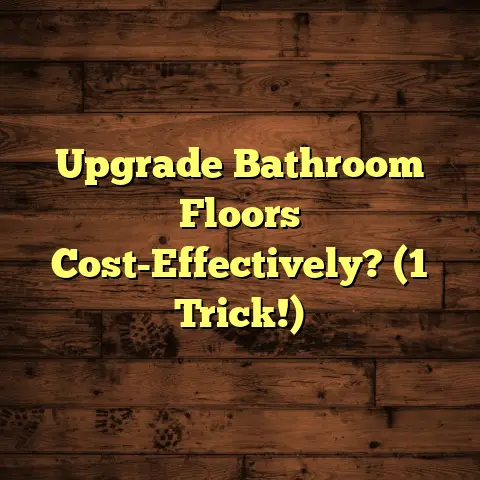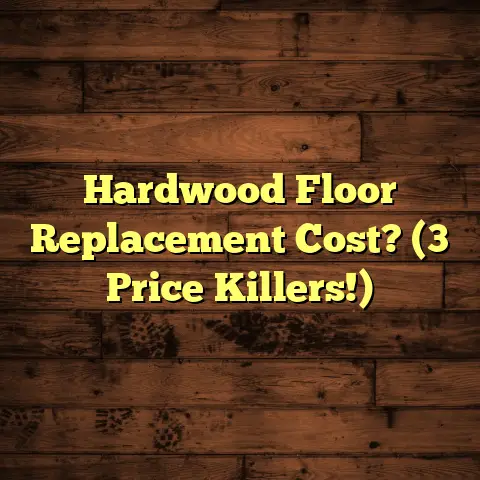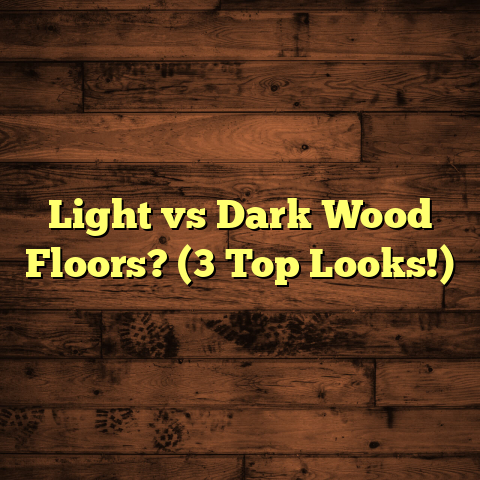Vinyl Plank on Porches: Viable? (Avoid This Mistake!)
Picture this: a warm summer evening, the smell of barbecue wafting through the air, kids playing tag on the lawn, and friends gathered on the porch, laughing and sharing stories.
Your porch – it’s more than just an entryway; it’s an extension of your home, a place where memories are made, and connections are forged.
The joy of a well-designed porch, the comfort of familiar surroundings, the nostalgia of summer nights – it all hinges on creating an inviting atmosphere.
And what’s a key element of that atmosphere? The flooring, of course!
When homeowners start dreaming up renovations or upgrades for their porches, there’s often a surge of excitement and hope. I’ve seen it countless times.
One flooring option that often catches their eye is vinyl plank.
It looks great, seems affordable, and promises easy installation.
But hold on! Before you jump on the vinyl plank bandwagon for your porch, there’s a critical mistake you need to avoid.
Section 1: Understanding Vinyl Plank Flooring
So, what exactly is vinyl plank flooring?
Essentially, it’s a synthetic flooring option designed to mimic the look of hardwood. It’s typically composed of several layers:
- Wear Layer: The top layer, providing durability and resistance to scratches and stains.
- Print Layer: This layer gives the plank its realistic wood or stone appearance.
- Core Layer: The core provides stability and, in some cases, water resistance.
- Backing Layer: The bottom layer, offering cushioning and protection.
Vinyl plank comes in various styles, from realistic wood grains to modern tile looks, and is often installed as either:
- Glue-Down: Attached directly to the subfloor with adhesive.
- Click-Lock (Floating): Planks interlock, creating a “floating” floor that doesn’t require adhesive.
Vinyl has become incredibly popular throughout homes for good reason.
It’s water-resistant (some are even waterproof!), durable enough to withstand daily wear and tear, and relatively low-maintenance.
A quick sweep and occasional mop are usually all it takes to keep it looking its best.
Given these benefits, it’s no wonder homeowners consider vinyl plank for their porches.
The aesthetic appeal is undeniable, and the cost-effectiveness compared to real wood or stone is certainly attractive.
But is it always the right choice? That’s what we need to explore.
Section 2: The Allure of Vinyl Plank on Porches
Imagine stepping onto your porch, greeted by the warm, inviting look of wood-like vinyl plank flooring.
The sun is setting, casting a golden glow on the planks, highlighting their realistic grain and texture.
It’s a picture of relaxation and comfort, a space you’re proud to share with family and friends.
I’ve seen firsthand how vinyl plank can transform a porch from a drab, concrete slab into an extension of the home’s living space.
It instantly adds character and charm, creating a welcoming atmosphere.
Beyond aesthetics, vinyl plank offers practical advantages for porches.
Its moisture resistance is a huge plus, especially in areas prone to rain or humidity.
Spills and tracked-in dirt are easily cleaned up, making it a low-maintenance option for busy homeowners.
I once worked with a homeowner, Sarah, who had successfully used vinyl plank on her covered porch.
She told me, “I was so tired of scrubbing the old concrete. The vinyl plank is beautiful, easy to clean, and has held up great to the weather. It’s made our porch our favorite spot in the house!”
(Note: Sarah’s success was due to using outdoor-rated vinyl plank, a crucial distinction we’ll discuss later.)
The allure of vinyl plank on porches is strong, and for good reason. It offers a combination of beauty, practicality, and affordability that’s hard to resist.
Section 3: The Mistake to Avoid
Here’s where things get critical.
The biggest mistake homeowners make when choosing vinyl plank for their porches is failing to understand the difference between indoor and outdoor vinyl planks.
This oversight can lead to a whole host of problems, turning your dream porch into a source of frustration and disappointment.
Many homeowners assume that all vinyl plank is created equal, or that the water resistance that makes it suitable for bathrooms and kitchens automatically makes it suitable for outdoor use.
This is simply not the case.
Outdoor vinyl plank is specifically engineered to withstand the harsh conditions of the outdoors.
This includes:
- Extreme Temperature Fluctuations: Outdoor vinyl is designed to expand and contract without warping or cracking in response to hot and cold weather.
- UV Exposure: Outdoor vinyl contains UV inhibitors to prevent fading and discoloration from prolonged sun exposure.
- Moisture and Mold Resistance: Outdoor vinyl is often fully waterproof and treated to resist mold and mildew growth, which can thrive in damp outdoor environments.
Indoor vinyl plank, on the other hand, is typically not designed to handle these conditions.
It may lack the necessary UV protection, temperature resistance, and moisture barriers, making it vulnerable to damage when exposed to the elements.
I remember a project where a homeowner, Tom, installed indoor vinyl plank on his uncovered porch.
He was thrilled with the initial look, but within a few months, the planks started to buckle, fade, and develop mold.
He was devastated, and the cost to replace the flooring was significant.
Tom’s story is a cautionary tale.
Choosing the wrong type of vinyl plank for your porch can have serious consequences.
Section 4: Consequences of the Mistake
So, what exactly happens when you install indoor vinyl plank on an outdoor porch?
The consequences can be both costly and frustrating. Here’s a breakdown of the potential problems:
- Warping and Buckling: Temperature fluctuations can cause indoor vinyl planks to expand and contract excessively, leading to warping, buckling, and even separation of the planks.
- Fading and Discoloration: Prolonged exposure to sunlight can cause the print layer of indoor vinyl plank to fade and discolor, ruining its aesthetic appeal.
- Mold and Mildew Growth: Moisture can seep into the seams and under the planks, creating a breeding ground for mold and mildew, which can be unsightly, unhealthy, and damaging to the subfloor.
- Cracking and Chipping: Indoor vinyl plank may become brittle and prone to cracking and chipping when exposed to extreme temperatures and weather conditions.
- Costly Repairs: Replacing damaged vinyl plank can be expensive, especially if the entire floor needs to be replaced.
- Safety Hazards: Warped or buckled planks can create tripping hazards, posing a risk to you, your family, and your guests.
I’ve seen homeowners invest significant time and money into their porch flooring, only to watch it deteriorate within a year or two due to this critical mistake.
The regret and frustration are palpable.
They envisioned a beautiful, inviting space, but instead, they’re left with a damaged, unsightly mess.
It’s heartbreaking to witness their disappointment, knowing that it could have been avoided with a little more knowledge and careful consideration.
Section 5: Making Informed Choices
Now, let’s talk about making informed choices.
I’m not going to tell you exactly what flooring to choose for your porch.
That decision is deeply personal and depends on your individual needs, budget, and aesthetic preferences.
However, I can guide you through the thought process necessary to make the right decision for you.
Start by reflecting on your personal experiences with your porch.
What does this space mean to you? What kind of atmosphere do you want to create? What kind of activities will take place there?
Consider the emotional value of your porch.
Is it a place of relaxation, connection, or entertainment? How important is it to you that your porch looks beautiful and inviting?
Think about the importance of lasting quality in your flooring choice.
Are you willing to invest a little more upfront to ensure that your flooring will withstand the elements and last for years to come?
Ask yourself these questions, and let your answers guide your research and decision-making process.
Talk to flooring professionals, research different types of outdoor flooring, and carefully consider the pros and cons of each option.
Don’t be afraid to ask questions and seek expert advice.
Remember, your porch is an extension of your home and a reflection of your personal style.
Choosing the right flooring is an investment in your home’s value, your family’s comfort, and your own peace of mind.
Conclusion: A Call to Reflection
As we wrap up, I want to invite you to reflect on your aspirations for your porch.
What do you envision for this space? Do you see it as a place of laughter, relaxation, or connection?
Remember the emotional significance of your porch.
It’s more than just an outdoor space; it’s a place where memories are made and relationships are nurtured.
Making well-informed choices that honor those feelings is important.
Don’t let the allure of a seemingly quick and easy solution lead you to make a costly mistake.
Avoid the common pitfall of installing indoor vinyl plank on your outdoor porch.
Your porch can be a source of joy and comfort for years to come, as long as you choose wisely.
Take the time to research your options, consider your needs, and make a decision that will stand the test of time.
Don’t delay!
The sooner you start planning and researching, the sooner you can transform your porch into the beautiful, inviting space you’ve always dreamed of.





